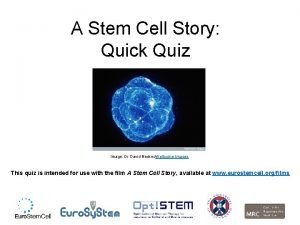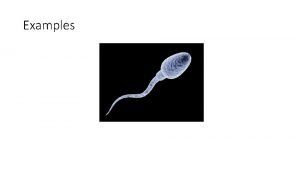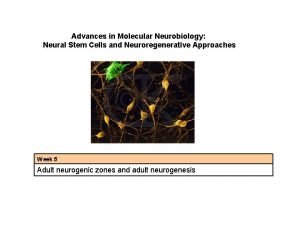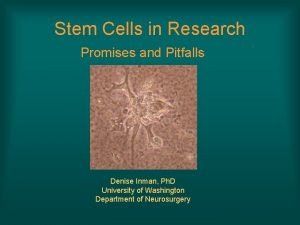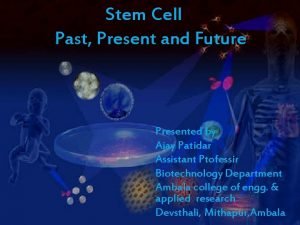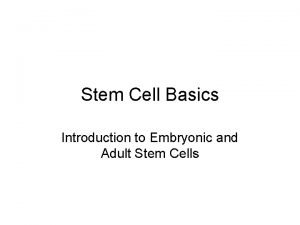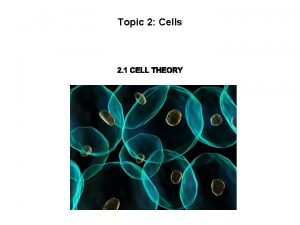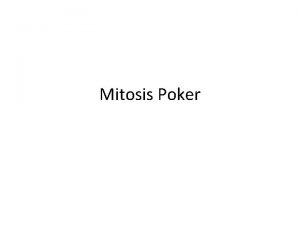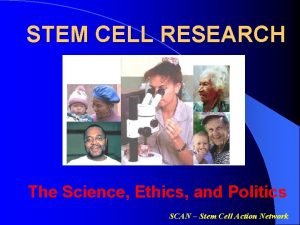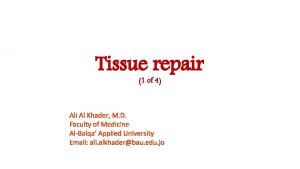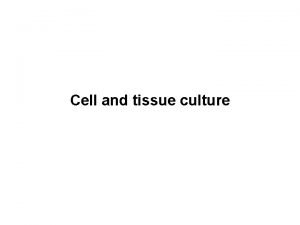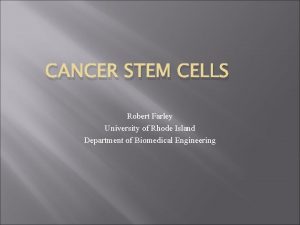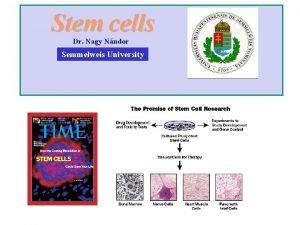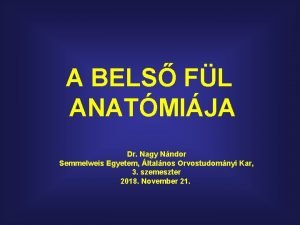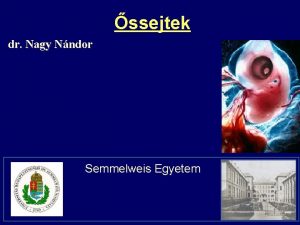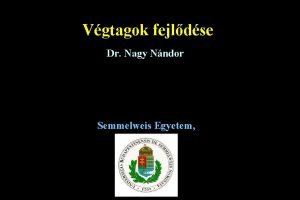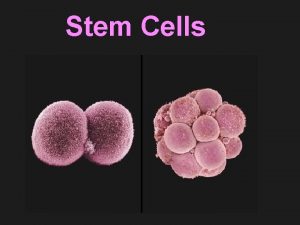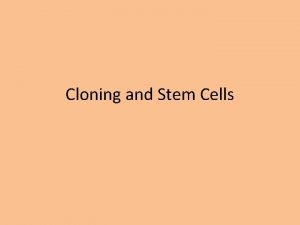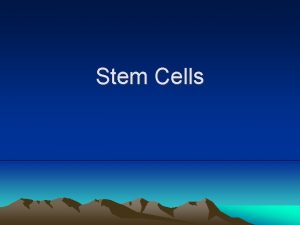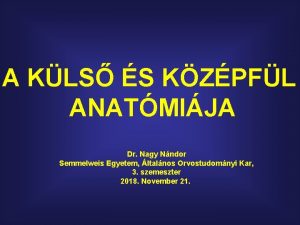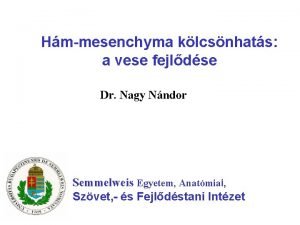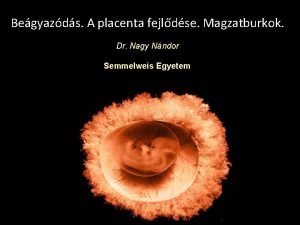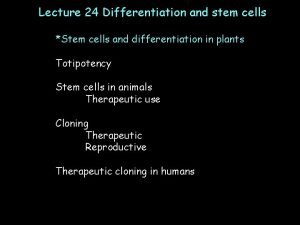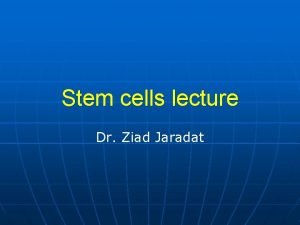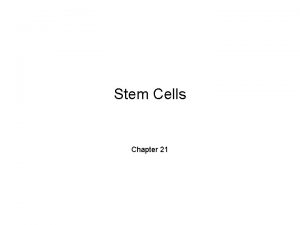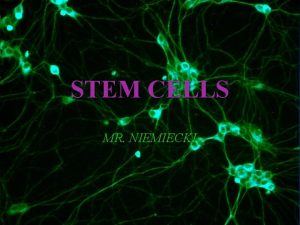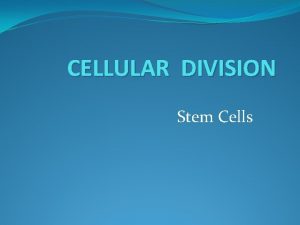Stem cells Dr Nagy Nndor Semmelweis University cell



































- Slides: 35

Stem cells Dr. Nagy Nándor Semmelweis University


cell. Stem cells What are stem cells? Stem cells are unspecialized cells that have two defining properties: the ability to differentiate into other cells and the ability to self-regenerate. The three broad categories of stem cells are: embryonic stem cells, derived from blastocysts, adult stem cells, which are found in adult tissues, and cord blood stem cells, which are found in the umbilical cord. Multipotent tissue stem cells


Potency of the stem cell. Totipotent stem cells are produced from the fusion of an egg and sperm cell. Cells produced by the first few divisions of the fertilized egg are also totipotent. These cells can differentiate into embryonic and extraembryonic cell types. Pluripotent stem cells are the descendants of totipotent cells and can differentiate into cells derived from any of the three germ layers. Multipotent stem cells can produce only cells of a closely related family of cells (e. g. hematopoietic stem cells differentiate into red blood cells, white blood cells, platelets, etc. ). Unipotent cells can produce only one cell type, but have the property of self-renewal which distinguishes them from non-stem cells.



Totipotent stem cells Pluripotent (embryonic) stem cells

Leroy Stevens Pluripotens őssejtek lehetséges forrásai (kezdeti próbálkozások): Teratómák (1: 35. 000), embryonális karcinómák.




Alcaline phosphatase Oct 4 and NANOG transcription factors SSEA 1 molecule


Mario Capecchi, Oliver Smithies és Martin Evans 2007. Nobel-prize for their discoveries of principles for introducing specific gene modifications in mice by the use of embryonic stem cells.


As development proceeds, there is a loss of potential and a gain of specialization, a process called determination

In adult organisms, stem cells and progenitor cells act as a repair system for the body, replenishing specialized cells, but also maintain the normal turnover of regenerative organs, such as blood, skin, or intestinal tissues

Asymmetric cell division Self-regeneration is the ability of stem cells to divide and produce more stem cells. During early development, the cell division is symmetrical i. e. each cell divides to gives rise to daughter cells each with the same potential. Later in development, the cell divides asymmetrically with one of the daughter cells produced also a stem cell and the other a more differentiated cell.

liver Liver disease Stroke brain Skeletal muscle Bone marrow bone Leukaemia, lymphoma. . . Blood cells Érfal distrophy Bone marrow stromal cells Epithelial cells adipocyte Heart muscle neuron neuropathies Heart disease glia

Hematopoietic stem cells generate a hierarchy of differentiation. • • Pluripotent stem cells reproduce to give rise to the myloid cells (the erythrocytes (RBC) and the leukocytes (WBC) - eosinophils, neutrophils, basophils, monocytes and megakaryotes) and the lymphoid cells (B and T lymphocytes). Initially pluripotent, the stem cell first becomes committed to either the lymphoid or myeloid lineages. This is followed by rounds of replication and further commitment to give the final 8 cell types. This occurs in the bone marrow and is regulated by growth factors and cytokines.

Epithelial stem cells in the mammalian gut and skin.

Stem cells in the brain bulbus olphactorius hippocampus

Roth A: Plastic repair of conjunctival defects with fetal membrane. Arch Ophthalmol 1940, 23: 522 -


indukált

ES cell transcription factor network and implications for reprogramming Yamanaka method: Myc disrupts chromatin OCT 4 and Sox 2 restore the pluripotency Klf 4 cofactor and apoptosis inhibitor Zwaka, T. P. Nature. 2010; 467: 280 Hochedlinger, K. et al. Development 2009; 136: 509 -523


Potential applications of i. PSCs. Stadtfeld M , Hochedlinger K Genes Dev. 2010; 24: 22392263 © 2010 by Cold Spring Harbor Laboratory Press




Heather A. Mc. Cauley, and James M. Wells Development 2017; 144: 958 -962 © 2017. Published by The Company of Biologists Ltd

2018: The year of the organoid A brave new world of lab-grown body parts

Advantages of organoid models for studying adult stem cells. Lyndsay M. Murrow et al. Development 2017; 144: 998 -1007 © 2017. Published by The Company of Biologists Ltd
 Semmelweis
Semmelweis Territorial matrix vs interterritorial matrix
Territorial matrix vs interterritorial matrix Semmelweis university faculty of medicine
Semmelweis university faculty of medicine Where can scientists obtain stem cells? *
Where can scientists obtain stem cells? * Pluripotent stem cells examples
Pluripotent stem cells examples Stem cells
Stem cells Conclusion of stem cells
Conclusion of stem cells Cellpast
Cellpast Adult stem cells
Adult stem cells Classification of stem cells
Classification of stem cells Structure x in the diagram below is a
Structure x in the diagram below is a Outline the cell theory
Outline the cell theory Stem cells webquest
Stem cells webquest Stem cells specialization
Stem cells specialization Paranasal sinuses development
Paranasal sinuses development Loop of henle
Loop of henle Pineal gland
Pineal gland Gametic cells vs somatic cells
Gametic cells vs somatic cells Why dna is more stable than rna
Why dna is more stable than rna Chlorocruorin
Chlorocruorin Prokaryotic vs eukaryotic transcription worksheet
Prokaryotic vs eukaryotic transcription worksheet Plant vs animal cell venn diagram
Plant vs animal cell venn diagram Prokaryotic cell
Prokaryotic cell Cell organelle jeopardy
Cell organelle jeopardy Masses of cells form and steal nutrients from healthy cells
Masses of cells form and steal nutrients from healthy cells Younger cells cuboidal older cells flattened
Younger cells cuboidal older cells flattened Prokaryotic cells vs eukaryotic cells
Prokaryotic cells vs eukaryotic cells Are red blood cells prokaryotic
Are red blood cells prokaryotic Nondisjunction in meiosis
Nondisjunction in meiosis Cells cells they're made of organelles meme
Cells cells they're made of organelles meme Stem cell multiple choice questions
Stem cell multiple choice questions Keva stem cell
Keva stem cell Stem cell politics
Stem cell politics Stem cell
Stem cell Stem cell culture
Stem cell culture Stem cell treatment rhode island
Stem cell treatment rhode island



